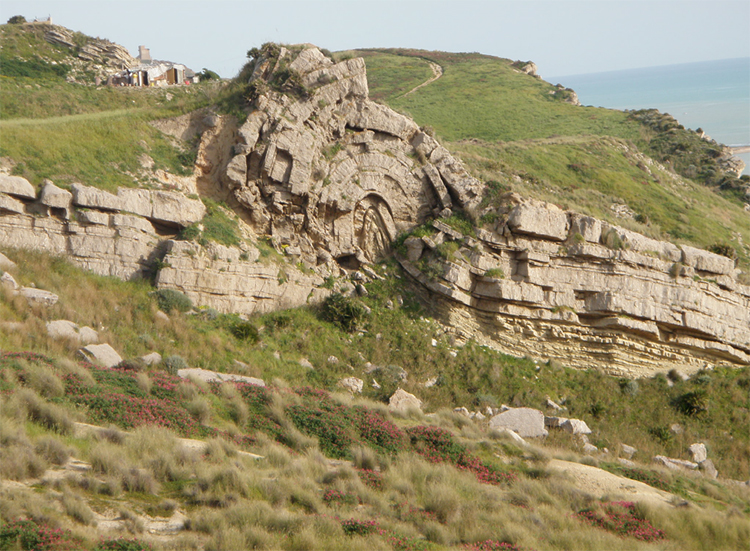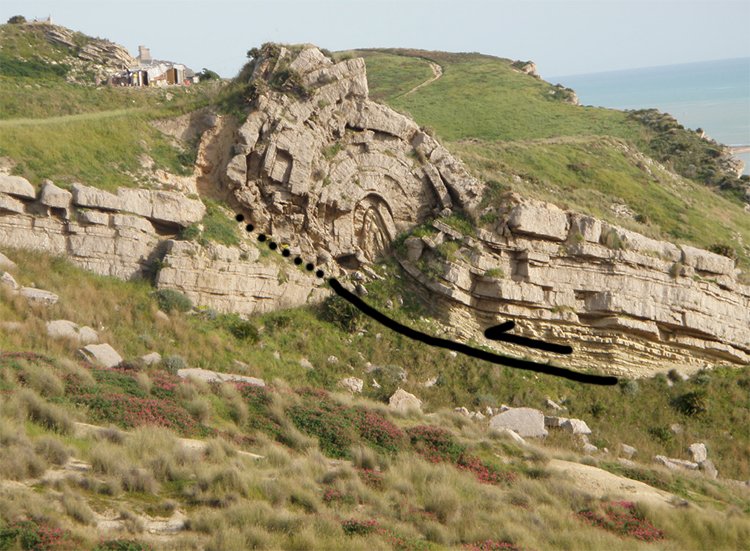Darrel Cowan, professor of geology at the University of Washington, is a frequent Friday Fold contributor. He pitches in today with a real show stopper:

Darrel writes:
In 2010, I was on the south coast of Sicily with my Italian colleague, Prof. Stefano Lugli, from the University of Modena. We spotted this fold, looking SE, in what is called the “upper gypsum” unit of the Messinian evaporatic strata. Stefano wrote me that the location is at Giallonardo close to Siculiana.
I present the structure as a fault-propagation fold, and in the second image I add my interpretation: the position of the fault changes from parallel to layering to where it ramps up and cuts across the footwall strata into the hinge of the syncline.

Callan again here. That looks right to me; the annotation presented here is my own, with the fault drawn as a solid black line parallel to layering, and dotted in black where it ramps up across the strata. I’ve opted for that annotation scheme because while the rock in the fault zone appears crushed up (resulting the one zone of relatively poor exposure), it doesn’t appear like there’s much offset along this fault yet. In other words, I see this as an incipient fault-propagation fold. If deformation were to proceed, I’d really expect that sequence of massive-bedded gypsum to show more displacement on either side of the fault.
The other thing Darrel alluded to but I think deserves to be expanded on is that this package of “Messinian evaporatic strata” is extraordinary as a stratigraphic phenomenon in its own right, regardless of whether it’s been folded. About 6 million years ago, the Strait of Gibraltar closed, preventing the waters of the Atlantic Ocean from mixing with the Mediterranean Sea. The climate over the Mediterranean is arid, and as the evaporation:replenishment ratio approached infinity, the sea dried up. All the solutes swimming around as ions in that seawater became more and more concentrated as the water evaporated, and they eventually precipitated out as layers of salt and gypsum and limestone. It’s an extraordinary event which basically transformed this sublime body of water into a hellish sort of mega-Dead-Sea landscape for a time. Wikipedia has a nice introductory summary here.
We can infer then, that the deformation that Darrel and Stefano observed in Sicily must be younger than the Messinian “Salinity Crisis,” as you can’t deform something until it’s first formed, and that means it’s less than 6 million years old. This is a very young fold, popping up out the landscape. It may well be that movement along the fault will fold it further in the future, and that offset I want to see will be there someday after an earthquake or two.

Dear Dr. Bentley
Great photo of one of the most dramatic and unusual outcrops I have ever seen. It was part of my Ph.D. thesis study and I took Lugli and Cowen to the outcrop (st different times and then we went together). Arvedo Decima, an Italian geologic survey geologist, showed numerous photos of this outcrop years ago and he loved to show this structure as a true anomaly. The calcareous ‘shales’ that underly these beds are not at all lithified and those clays are totally unlithified while the gypsum was precipitated as a rigid crystalline substance (gypsum). Gerry Friedman, my prof, could scarcely believe it because he felt that “gypsum” originated as anhydrite that was later hydrated (altered). I finally took him to a salt works and showed him the gypsum crystals forming directly in the concentrated marine water. By the way, in the modern salinas the gypsum crystals often contain the same cyanobacterial filaments as do some of the Messinian crystals.
This is a lovely little displacement. But there is something unsettling in the phrasing of this post. This “incipient fault-propagation fold..if deformation were to proceed” that is “popping up out the landscape” could mislead a non-geoscience reader into believing that there may be additional faulting and folding of this structure at some future date. Surely the conditions that resulted in this décollement involved the presence of gravitationally forced horizontal stresses that have since dissipated with the removal of the significant overburden? With nothing but the coast nearby, it is difficult to imagine any future driver for additional displacement and folding, at least in this age. It is likely that I am misreading and/or over-reading the intent of the language, but an AGU Blog should be written so as to avoid being misunderstood. That said, thanks for the photo, it’s a beauty!
Really interesting